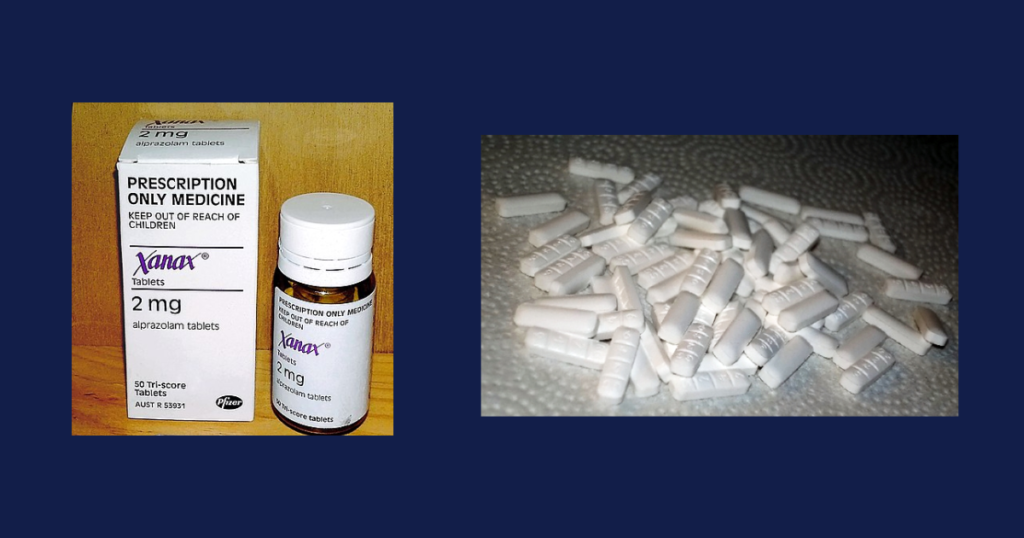Xanax is the general name of the benzodiazepine prescription medication alprazolam, which is used to treat anxiety, panic disorders and insomnia. Xanax is one of the most prescribed medications in the country. While there are medical benefits to Xanax, the drug is extremely addictive and in recent years has become widely used for recreational purposes. It’s not uncommon for teens to swipe a few Xanax pills from their parents’ medicine cabinets.
The increasing popularity of the drug has brought it to the mainstream light, it is something that is seen on college campuses and mentioned in popular music. Because Xanax is such a new drug, most people don’t know or understand much about it, like just how harmful it can be.
What is Xanax and What Does Xanax Do?
As mentioned above, Xanax is a prescription drug used to treat anxiety and panic disorders. Xanax is benzodiazepine. Benzodiazepines were first created in 1956 by Dr. Leo Sternbach in an attempt to craft a safer alternative to tranquilizer drugs. However, the first patent for alprazolam was not issued until the 1970s to J.B. Hester and it was first introduced in the United States market in the early 1980’s. After entering the market, Xanax became one of the most prescribed and most abused benzodiazepines in the country.
Following oral administration, Xanax is absorbed, which is one of the reasons it is used recreationally, because the effects can be felt so quickly. Peak levels of the drug are in the body one to two hours after using and the drug is generally out of the body after 11 hours. Xanax is known to be a habit-forming medication and is not supposed to be taken with alcohol or is you are pregnant as it can cause birth defects or withdrawal symptoms in a newborn.
Anxiety disorders are described as “unrealistic or excessive anxiety and worry (apprehensive expectation) about two or more life circumstances, for a period of 6 months or longer, during which the person has been bothered more days than not by these concerns.” Some symptoms for anxiety disorder include:
- Trembling
- Feeling shaky
- Muscle tension
- Soreness
- Restlessness
- Shortness of breath
- Accelerated heart rate
- Feeling on the edge
Meanwhile, panic disorders are characterized by unexpected panic attacks or a period of intense fear or discomfort in which some of the following symptoms develop:
- Pounding heart
- Sweating
- Trembling
- Sensations of shortness of breath
- Feeling of choking
- Dizziness and more
Xanax Dependence
While it is possible to take Xanax without building a dependence to the drug or risking damage to your brain or body, even patients who take the drug as prescribed can develop an addiction. The FDA acknowledges this risk exists for those who are prescribed the medication. “Even after relatively short term use at the doses recommended for the treatment of transient anxiety and anxiety disorder (ie, 0.75 to 4.0 mg per day), there is some risk of dependence.” They further admit that it’s not just those with anxiety that are at risk.
“Risk of dependence and its severity appear to be greater in patients treated with doses greater than 4 mg/day and for long periods… Because the management of panic disorder often requires the use of average daily doses of XANAX above 4 mg, the risk of dependence among panic disorder patients may be higher than that among those treated for less severe anxiety,” according to the FDA.
Those who take Xanax medically or recreationally are at risk for developing a physical or psychological dependence on it. Physical dependence can be harsh for anyone suffering from substance abuse whether it be prescription drugs, alcohol, nicotine or something else. However, because Xanax is meant to provide those prescribed to it noticeable physical changes, it can be even more intense for those who abuse it with higher doses or mix with other drugs.
Psychological dependence is a risk patients of any benzodiazepine run when taking the drug. The FDA says that risk is increased for those with a higher dosage or those with a history or alcohol or drug abuse. The mental side of Xanax dependency can lead to missing work, financial problems, lack of energy or motivation and low interest in tasks that require attention.
Risks of Xanax
The list of risks that are caused from prescribed or recreational Xanax use is long. Not only can users build up a dependency that can influence their actions when off the drug, but even when a patient tries to taper off the drug it can cause some frightening withdrawal effects.
Xanax, or benzodiazepines, are believed to have been involved in 17% of all drug overdose deaths between January 2019 and June 2020, according to the Centers for Disease Control and Prevention. That’s a 520% increase from the pervious time period. It’s estimated that 8,000 deaths each year are attributed to benzodiazepines. The increase in recreational abuse may be a side effect of the spike in prescriptions and drugs available. Prescription rates for the anxiety drug have been climbing at a 9 percent rate since 2008. Also, data from the National Institute of Drug Abuse found that the use of benzodiazepines is high while the disorders that deem the drug necessary are low. In fact, only 20 percent of people who have used this type of drug received them from their doctor, others used other methods to obtain the drug.
Fetal Harm
Using Xanax during a pregnancy, or if a patient becomes pregnant while taking this drug, can be a potential hazard for the fetus. Using Xanax during the first three months of pregnancy can raise your baby’s risk of birth defects including cleft lip, cleft palate and other problems. Meanwhile, Xanax use during the subsequent six months can cause the baby to experience withdrawal symptoms including trouble breathing, problems with eating and dehydration. Xanax use in the late stages of pregnancy can also cause floppy infant syndrome, a condition that can last between 2 and 3 weeks, in which the baby’s muscles are week and have trouble controlling their head, arms or legs. If you are pregnant or think you may become pregnant talk to your doctor about what medications you can safely continue.
Seizures
Seizures are one of the most dangerous side effects that occur from Xanax use and withdrawal. While FDA studies show that it is not seen in everyone, it is still a possibility for all who use the drug. Seizures due to Xanax can be life-threatening and generally occur when the dosage of the drug is reduced too rapidly or discontinued abruptly. The risk for seizures is also greater for those with higher dosages, specifically at doses above 4 mg/day. Also, patients who have a history of seizures or with epilepsy should be cautious of using the drug as it may increase the likelihood of experiencing a seizure. Be sure to follow your doctor’s orders when taking Xanax.
Xanax Overdose
Overdosing on Xanax is possible. Experiencing an overdose from just Xanax tablets is less common due to the amount needed. But, if used along with other drugs or alcohol the risk runs substantially higher. Alcohol specifically seems to be one of the biggest triggers for seizure, which can lead to death. “Fatalities have been reported in patients who have overdosed with a combination of a single benzodiazepine, including alprazolam, and alcohol; alcohol levels seen in some of these patients have been lower than those usually associated with alcohol-induced fatality,” the FDA found.
Other withdrawal symptoms that can occur from Xanax use when lowering dosage or stopping abruptly include:
- Heightened sensory perception
- Muscle cramps
- Muscle twitches
- Diarrhea
- Blurred vision
- Loss in appetite
- Weight loss
- Impaired concentration and more
Alternatively, there are a number of side effects that can occur separately from withdrawal symptoms. Some common side effects that occur for individuals taking Xanax can be forgetfulness, loss of coordination, irritability, tiredness, slurred speech and more. Some less common side effects that can still occur include stomach pain, memory loss, nausea, headaches and more. Genetics, kidney function and gender are three things that can play a role in how or if these side effects will have an effect on someone using Xanax.
There are things that can be done to influence or inhibit the severity of these side effects. For example the higher the dosage, the greater the risk of side effects. Also, if other drugs or alcohol are being used with Xanax, this runs a greater risk of experiencing some side effects. Other factors that can influence this are diet, levels of hydration and knowledge of the medicine.
There are some general precautions when it comes to taking Xanax as well. For instance, suicide is one risk that comes with taking a psychotropic medication meant to affect the mental state like Xanax. This may have more to do with the patient’s state before being administered the drug but is a risk regardless. Hypomania and mania, elevated or unusually irritable moods, have also been reported among users of Xanax, especially those with depression.
Treatment for Xanax Abuse and Addiction
Going to a drug treatment center for a Xanax addiction could be necessary for someone who is experiencing a severe dependency on the drug. The first step toward recovery is recognizing the problem and seeking help from a loved one, doctor or other professional on what to do. Speaking with a doctor can help you further identify problems and understand the a treatment program. If going to a treatment center is needed, the patient will go through a detoxification program.
Medical detox is important for people who are suffering from a Xanax-dependency due to the risk of seizures and other medical problems. Patients will slowly be weaned off Xanax over the course of the detox program which can take a week or more. This will allow your body to avoid the major withdrawal symptoms associated with abrupt change in dosage.
Depending on the treatment center, patients will then move to either inpatient care or are discharged and take on outpatient treatment programs. Inpatient, or residential, treatment is 24-hour supervision as the patient attends individual and group therapy sessions as well as other activities with others who are suffering from similar scenarios. Inpatient treatment programs generally take 30 to 90 days. During the program, it is likely that the patient will go through cognitive behavioral therapy. This is a type of one-on-one counseling where the patient identifies certain triggers that causes the patient to abuse Xanax, or other drugs, in an attempt to prepare for the situations in the future. This type of therapy might also help to relieve symptoms of anxiety or panic disorder, the two problems that cause Xanax prescriptions in the first place.
Outpatient care gives patients the chance to adjust to their new sober life in a more independent setting, moving back to their homes and attending therapy or counseling session a few times a week. Outpatient care generally takes around 10 weeks but can change depending on the patient’s personal situation. There are similarities between inpatient and outpatient care in terms of therapy but it gives patients a chance to prove to themselves and loved ones that they can adjust to a new sober life without the need for constant supervision.
Next Steps
Drug and alcohol addictions can be a powerful thing, not just for the person suffering but for family and friends. Recognizing drug or alcohol addiction in yourself or a loved one can be a hard thing, and reaching out for help can be even more difficult. But at Landmark Recovery, we believe that by creating a supportive network within drug treatment/alcohol treatment to educate you on the effects and dangers of addiction that can help lead you to the next chapter of your life and begin a life of sobriety.

Choose Recovery Over Addiction
We're here 24/7 to help you get the care you need to live life on your terms, without drugs or alcohol. Talk to our recovery specialists today and learn about our integrated treatment programs.






